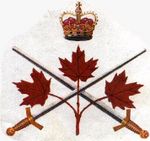The Canadian Army: Difference between revisions
No edit summary |
No edit summary |
||
| (7 intermediate revisions by 2 users not shown) | |||
| Line 1: | Line 1: | ||
{|align="right" border="0" cellpadding="2" cellspacing="2" | |||
| | |||
{|align="right" border="2" cellpadding="2" cellspacing="0" | |||
|align="center" style="background:red; color:white"|<b><div style="font-size: 80%">The Canadian Army</div></b> | |||
|- | |||
|align="center"|[[Image:Canadian_Army.jpg|150px]] | |||
|- | |||
| | |||
{| | |||
| | |||
{|align="center" | |||
|align="center"|<div style="font-size: 80%">[[Militia]] 1867 to 1940</div> | |||
|- | |||
|align="center"|<div style="font-size: 80%">[[The Canadian Army|Army]] 1940 to 1968</div> | |||
|- | |||
|align="center"|<div style="font-size: 80%">[[Force Mobile Command|FMC]] 1968 to 1997</div> | |||
|- | |||
|align="center"|<div style="font-size: 80%">[[Land Force Command|LFC]] 1997 to today</div> | |||
|} | |||
|} | |||
|} | |||
|} | |||
"The Canadian Army" was the name of Canada's land forces from 1940 until February 1, 1968. | "The Canadian Army" was the name of Canada's land forces from 1940 until February 1, 1968. | ||
| Line 13: | Line 36: | ||
Prior to the coronation of Queen Elizabeth II, the Canadian Army was the only Imperial/Commonwealth nation to have provided the King's Guard in London. In the lead up, the contingent of Canadian troops sent for the coronation provided the guard during June 1953, along with an equivalent unit of the Australian Army. | Prior to the coronation of Queen Elizabeth II, the Canadian Army was the only Imperial/Commonwealth nation to have provided the King's Guard in London. In the lead up, the contingent of Canadian troops sent for the coronation provided the guard during June 1953, along with an equivalent unit of the Australian Army. | ||
The Army was amalgamated with the Royal Canadian Navy and the Royal Canadian Air Force on February 1, 1968. The newly formed Canadian Forces was the first combined command military force in the modern world. Helicopter operations transferred to Air Command. The Army became known as [[Force Mobile Command]] (FMC), and later Land Force Command (LFC), although the term "Canadian Army" is still used today. | The Army was amalgamated with the Royal Canadian Navy and the Royal Canadian Air Force on February 1, 1968. The newly formed Canadian Forces was the first combined command military force in the modern world. Helicopter operations transferred to Air Command. The Army became known as [[Force Mobile Command]] (FMC), and later [[Land Force Command]] (LFC), although the term "Canadian Army" is still used today. | ||
==Local Links== | |||
*[http://army.ca/info/junior_officers_guide.php The Junior Officer's Guide] (1959) | |||
==External Links== | |||
*[http://en.wikipedia.org/wiki/Canadian_army Wikipedia entry for Canadian Army] | |||
*[http://www.canadiansoldiers.com/mediawiki-1.5.5/index.php?title=Canadian_Army Detailed historical lineage of the Canadian Army] | |||
[[Category:Canadian Military History]] | |||
Latest revision as of 21:18, 19 March 2009
|
"The Canadian Army" was the name of Canada's land forces from 1940 until February 1, 1968.
Canada declared War on Nazi Germany on September 10, 1939, following the British and French declarations of war several days before. The Canadian First Army was in overall control of Canadian land forces. The Canadian First Army participated in many of the land battles in Europe.
Canada led the failed Dieppe Raid (Operation Jubilee) on August 19, 1942, landing nearly 5,000 soldiers of the 2nd Canadian Division and 1,000 British commandos on the coast of occupied France, in the only major combined forces assault on France prior to the Normandy invasion of June 1944. Despite air support from Allied fighters and bombers and a naval fleet of 237 ships and landing barges, the raid was a disaster.
Later Canadian First Army troops took part in the Allied invasion of Italy. On June 6, 1944, the 3rd Canadian Division landed on Juno Beach in the Battle of Normandy. Troops sustained 50% casualties in their first hour of attack. By the end of D-Day, the Canadians had penetrated deeper into France than either the British or the American troops at their landing sites and while overcoming stronger resistance than any of the other beachheads except Omaha Beach.
Canada also played a role in the Pacific Theatre. Upon the request of the British Government, Canada agreed to send reinforcement to garrison Hong Kong, therefore freeing up troops for other British possessions in the Far East. The Department of National Defence sent 1975 soldiers from the Royal Rifles of Canada (from Quebec City) and the Winnipeg Grenadiers. However, the Canadian forces in Hong Kong did not have much of an impact when Japan invaded the crown colony on December 8, 1941 (see Battle of Hong Kong). Later, in 1944, the Canadian Government sent some of their Chinese-Canadian recruits into occupied Malaya as spies and trainers of the local guerrillas.
Canada had the 4th largest Army in the world following the end of World War II, leading to large cutbacks to operate in peacetime. Despite this, the Canadian Army saw action in the Korean War, forming part of the British Commonwealth Forces Korea and taking part in the Battle of Kapyong.
Prior to the coronation of Queen Elizabeth II, the Canadian Army was the only Imperial/Commonwealth nation to have provided the King's Guard in London. In the lead up, the contingent of Canadian troops sent for the coronation provided the guard during June 1953, along with an equivalent unit of the Australian Army.
The Army was amalgamated with the Royal Canadian Navy and the Royal Canadian Air Force on February 1, 1968. The newly formed Canadian Forces was the first combined command military force in the modern world. Helicopter operations transferred to Air Command. The Army became known as Force Mobile Command (FMC), and later Land Force Command (LFC), although the term "Canadian Army" is still used today.
Local Links
- The Junior Officer's Guide (1959)
